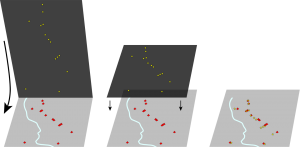Projection of the Star map on the Pyramid field
A Star map projected onto the Pyramid field?In order to prove my theory that the design of the Pyramid field is a projection (fig.6) of the constellation Orion, we need at least two pairs of fixed, correlating points to relate both plans irremovably to each other.
I actually discovered three such pairs of correlating points that enable us to fix the star map onto the Pyramid field. The counter-points on earth are the temple cities of Letopolis, Heliopolis and Memphis.
[new_royalslider id=”1″] Fig. 6
Letopolis, the throne of Horus
The words spoken by the High Priest of Ptah, Khaefsnofrou, uncle of pharaoh Cheops, are most intriguing: “The building (the pyramid) must be marked out [determining the location] under the protection [or with the help] of the god Horus, the Lord of Chem (Letopolis).” The precise translation of this sentence from the book of the French Egyptologist G. Goyon (Le Secret des bâtisseurs des grandes Pyramides Khéops, p.89) is difficult to understand. But the important part of the statement tells us that Horus is the Lord of Letopolis. Some research in this direction yielded the following explanation: according to the Lexicon der Ägyptologie, Arnebeschènis points to Horus of Letopolis (LÄ III, 41, 42, H. Altenmüller). The major star in the constellation Lepus, which is known as the chair of the giant and warrior Orion, is Arneb. The similarity makes it clear that this star Arneb, which is also known as the throne of Jauzah, correlates with the temple city of Letopolis. Therefore, the constellation of Lepus is the throne of Orion.
Giza, the Belt of Orion
Bauval’s theory has been rejected by the scientific community. Egyptologist Prof. Mark Lehner stated: “Robert Bauval suggests that the Giza diagonal is inspired by the stars in the belt of the constellation Orion, which the Egyptians saw as a symbol of Osiris. But when the map of Orion is positioned over that of Giza and nearby pyramids, it is clear that there are stars in Orion for which there are no matching pyramids, and pyramids for which there are no stars in Orion, or any other constellation.” (The Complete Pyramids, Lehner, p.107.)
I will show that the word Giza means Orion. The locations of Heliopolis, Letopolis, Memphis, Giza, Saqqara, Meidum and Seila are of fundamental significance in my theory. These seven locations are reliable reference points on which a star map (Uranometria 2000,0, W.Tirion) can be irremovably fixed. The basis of my theory is that the Pyramid field constitutes the heart of the Egyptian culture (The Constellation of Horus, chapter 4, Egypt – Image of Heaven, and Subpage 2: Technical Explanations). Apart from its remarkable planological design, the Pyramid field contains the most essential core of the technological, astronomical-cum-religious, ideological, cultural and economical dynamism of Ancient Egypt.
Giza signifies Orion
Geographic place names usually have a historical background which may lead back to interesting, albeit hidden facts. This is also the case with the place name Giza, the village in the neighbourhood of Cairo, where the pyramids of Khufu, Khafre en Menkaure (Cheops, Chefren and Mycerinos) are situated. In the 19th century, the name of this place was Jeezeh. The following orthographic varieties are known: Gyzeh, Ghizeh, Gizeh, Gizah, Jeezeh, Gheezeh, Jizeh, Djiza, Djise, Dschuseh, Geezeh, El-Geezeh, Dzireth, etc. According to Dr. J.A.S. Grant, the correct English spelling of this village is Jeezeh or Geezeh (The Great Pyramid, Piazzi Smyth, p. 4). In the Arab language, the present name of Giza is Ahramat Al Jizah. It is now more than one hundred years ago since anyone tried to pronounce the Arab place names correctly in English. Nowadays, we know of no other name than Giza.
Jizah and Jeezeh are, more than likely, derived from the old Arabic Al Jauzah, which signifies Orion (Star Names, Hinckley Allen, p. 307). Provided that this phonetic interpretation is correct, we have proof that more than one thousand years ago, the Arabs knew the real meaning of the name, namely Orion. The Arabs inherited this from the Egyptians.
